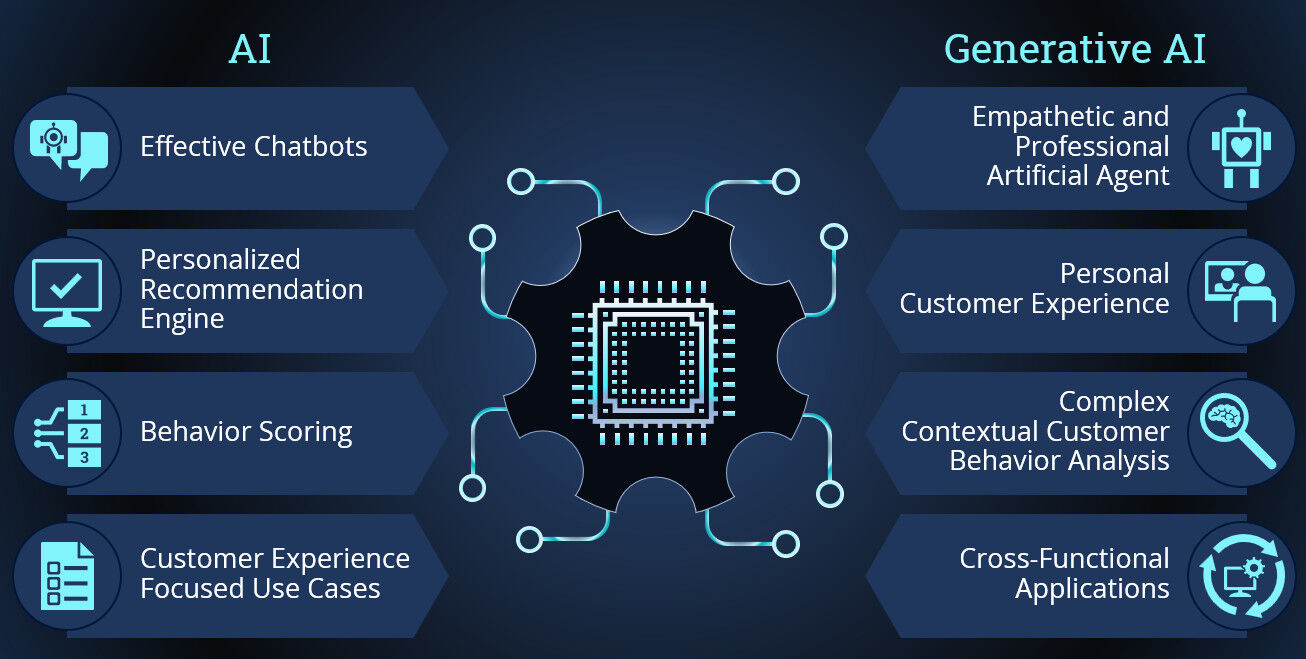
In the digital world, businesses face challenges that can hinder growth and operational efficiency. But what if there was a way to address these issues effectively? Enter Generative AI, a revolutionary technology capable of transforming business landscapes. How can Generative AI help businesses overcome inefficiencies in customer support, expand their global reach through multilingual support, or innovate content creation? What role does it play in detecting complex fraud schemes or managing overwhelming data? And crucially, how can it streamline supply chain management to respond to market demands more efficiently? These questions highlight the diverse problems Generative AI is poised to solve, making it an indispensable tool for modern businesses.
Curious to discover more about how Generative AI can revolutionize your business operations and drive unprecedented growth? Jump right into our detailed blog post to uncover the innovative solutions and strategies that can propel your company forward. Don’t let inefficiencies hold you back: embrace the future today!

What is Generative AI?
Generative AI refers to a category of artificial intelligence systems designed to produce content. There are subtle differences between Generative AI and AI but Generative AI is way advanced than traditional AI. Generative AI can curate text, images, music, or code that is typically indistinguishable from content created by humans. These systems leverage machine learning models, primarily deep learning neural networks. They understand and generate new data that simulate original human output. The capability is not just about replicating or copying existing examples. It involves the AI understanding underlying patterns and structures in vast datasets to innovate and create something new. This technology has been harnessed across various industries in the real world. From automating content creation for social media to developing new pharmaceuticals, it demonstrates its vast potential to enhance productivity and spur innovation.
The impact of generative AI extends beyond mere automation, influencing creative processes and decision-making in unprecedented ways. In the field of content creation, for example, these AI systems can suggest novel designs, write compelling narratives, or even generate music that resonates with human emotions. All are based on the input parameters and data they have been trained on. This capability allows for a significant reduction in the time and resources typically required for creative endeavors. It makes high-quality content more accessible and scalable. Moreover, as generative AI continues to evolve, it holds promise for even more sophisticated applications such as simulating complex environmental models for climate change predictions or creating realistic simulations for training medical professionals.
1. Inefficient Customer Support & Experiences
Generative AI is revolutionizing customer support by automating routine inquiries and personalizing interactions. For example, Zendesk uses AI to automate responses to common customer queries, enabling agents to concentrate on more complex cases. This shift not only speeds up resolution times but also improves the quality of support by allowing human agents to dedicate more attention to intricate customer issues.
- Efficient Operational Support with Generative AI: Using tools like Google Cloud AI, companies can analyze customer interactions extensively. Google Cloud AI excels in processing large volumes of data to identify patterns and recurring issues. For example, it has enabled a leading telecommunications company to analyze millions of customer interactions. It generated insights that led to a 50% reduction in complaint resolution time. It was achieved by identifying common technical issues and streamlining the troubleshooting guidelines.
- Expanding Global Reach through Multilingual Support: Generative AI excels in providing multilingual support, enabling companies like Airbnb to serve a global user base without expanding their human workforce. Using AI-driven platforms, Airbnb offers customer support in multiple languages, ensuring that responses are not only quick but also culturally and linguistically accurate, which minimizes customer frustration and enhances accessibility.
- Transforming Customer Experience with Hyper-Customized Interactions: Generative AI is pivotal in creating hyper-personalized customer interactions. For example, Netflix uses AI to analyze viewing patterns and preferences to recommend shows and movies. It boosts user engagement and satisfaction to a great extent. This kind of AI application ensures a seamless omnichannel experience. It allows customers to receive personalized interactions across various digital platforms, enriching the overall customer journey.

2. Overcoming Content Creation & Curation Hurdles (H2)
Generative AI provides targeted solutions to the subtle challenges of content creation and curation. It enhances efficiency and engagement for businesses. Here’s a more detailed and specific breakdown using real-time examples:
Content Creation: Generative AI transforms the approach of businesses towards content generation, making it more efficient and less resource-intensive. For example, OpenAI’s ChatGPT has been used by small, medium-sized, and even large enterprises to automatically generate customer service responses, marketing copy, and blog posts. This AI can generate an entire article based on just a few input keywords. It drastically reduces the time and effort required compared to traditional content creation. Similarly, Google’s GEMINI has also been integrated by online publishers to enhance search algorithms, making content more discoverable and relevant to user queries, which in turn improves engagement and SEO rankings.
Content Curation: AI-powered tools like Feedly and Flipboard are pivotal in revolutionizing content curation. Feedly uses AI to monitor the quality and relevance of articles across the web. It allows users to create customized news feeds based on their interests. For businesses, this means automated, up-to-date industry news curation, which can be used to keep teams informed or fuel content marketing strategies. Flipboard curates content into an easy-to-digest magazine format. It provides users with a streamlined experience that filters out noise and focuses on what’s important. It directly impacts engagement and retention rates.
Customer Engagement: Generative AI also plays a crucial role in enhancing customer engagement through personalized marketing. Salesforce Einstein is an AI platform that analyzes customer data to personalize email marketing campaigns. It predicts the best times to send emails and the content most likely to engage each recipient. This level of customization increases open rates and conversions by guaranteeing that messages resonate personally with each user. AI-driven chatbots on retail sites can provide personalized shopping advice and product recommendations based on browsing history and other customer data, simulating high-quality human interaction and improving user satisfaction.
3. Fraud Detection
Generative AI is redefining fraud detection in the business sector through real-time examples that demonstrate its effectiveness and adaptability. Here are specific ways in which Generative AI addresses fraud detection challenges:
- Real-time Anomaly Detection: Companies like Mastercard are using Generative AI to enhance their fraud detection systems. By generating synthetic data that mirrors fraudulent transaction patterns, these systems can detect anomalies more effectively. For example, Mastercard’s Decision Intelligence technology applies machine learning to each transaction to assess the likelihood of fraud, and this is enhanced by Generative AI’s ability to model and predict fraudulent behaviors based on historical data.
- Adaptive Learning for Enhanced Fraud Prevention: PayPal utilizes Generative AI to monitor transactions continuously. The AI models adapt and learn from each transaction, encouraging them to identify fraudulent behavior that deviates from the norm. This continuous adaptation helps PayPal stay ahead of sophisticated fraud tactics and reduce false positives.
- Leveraging NLP for Advanced Fraud Detection: Financial institutions are increasingly integrating Natural Language Processing (NLP) with Generative AI to parse through vast amounts of textual data such as customer support tickets, emails, and transaction logs. For example, JPMorgan Chase employs NLP techniques within its COIN platform to analyze legal documents and extract important data points and clauses. This capability extends to monitoring communication for potential fraud by detecting patterns and anomalies in the text that could indicate fraudulent activities.

4. Data Overload and Analysis Paralysis
Generative AI is proving to be an essential tool for businesses grappling with data overload and analysis paralysis. Here are some specific examples of how generative AI addresses these issues:
Managing Complex Datasets: For example, JPMorgan Chase is using generative AI to improve risk management and fraud detection. Their AI models analyze transactions in real-time, synthesizing vast amounts of data to detect patterns that might indicate fraudulent activities. This capability allows for rapid decision-making based on a comprehensive understanding of data, which is much more effective than traditional methods that can be slower and less adaptable.
Automating Data Analysis to Combat Analysis Paralysis: Autodesk uses generative AI to automate design processes in engineering. Their AI-driven tools process extensive datasets to predict stress points in materials used for construction. It allows engineers to optimize designs in real-time. This automation reduces the workload on their teams, who would otherwise need to manually analyze countless variables, thereby preventing analysis paralysis.

5. Supply Chain Management Breakdowns
Generative AI significantly enhances supply chain management by providing tailored solutions across various operational facets. Here’s how it specifically addresses each aspect with real-world examples:
Demand Forecasting and Inventory Optimization: Generative AI tools like IBM’s Watson leverage vast datasets encompassing historical sales data, market trends, and external factors to refine demand forecasting models. For example, a multinational company like Unilever uses AI to analyze patterns in consumer behavior across different regions. It leads to more accurate inventory stocking and distribution, which aligns production schedules with real market demand, minimizing overproduction and stockouts.
Risk Management and Predictive Maintenance: Companies such as Siemens employ generative AI to simulate various operational scenarios, including supply chain disruptions due to geopolitical events or sudden market changes. AI-driven predictive maintenance can anticipate machinery failures before they occur. By analyzing real-time sensor data, AI predicts when equipment maintenance is needed, reducing unexpected downtime and associated costs, thus ensuring continuous production flow.
Supplier Selection and Relationship Management: Generative AI systems analyze vast arrays of data on supplier performance and risk, much like how SAP Ariba uses AI to help businesses evaluate and manage supplier relationships. By assessing risk factors and historical performance data, companies can make more informed decisions about which suppliers to partner with.
Logistics and Route Optimization: AI-driven logistics platforms, such as Locus or Routific, optimize delivery routes by analyzing real-time traffic data, weather conditions, and delivery windows. For example, a logistics company can use these AI tools to reroute shipments instantaneously to avoid delays. It can maintain timely deliveries and reduce fuel costs.
Production and Innovation: Generative AI aids in resource management and scheduling in the manufacturing sector. Companies like General Electric use AI to optimize production workflows and reduce bottlenecks. In innovation, AI-driven tools like Autodesk’s generative design software allow engineers to create and simulate thousands of designs quickly, selecting the best one based on predefined criteria. It speeds up the design process, from initial concept to market-ready products.
Overall Supply Chain Integration: The strategic use of Generative AI in these aspects not only streamlines operations but also prepares businesses to adapt and respond to unexpected challenges swiftly. For example, Amazon has integrated AI across its supply chain from inventory management to delivery, using predictive analytics to anticipate customer demand and optimize stocking. It reduces operational costs and improves customer satisfaction.
Final Words
The terrific power of Generative AI is not just an asset, it’s a game changer across diverse business operations. From turbocharging customer support and broadening global reach to revolutionizing content creation and tightening fraud detection, Generative AI is the dynamo at the heart of modern business efficiency and innovation. Its pivotal role in refining supply chain management and tackling data overload paves the way for smarter, more agile business practices. As the digital landscape evolves, integrating Generative AI not only boosts operational efficiency but also sharpens your competitive edge.
Ready to leap into the future? Generative AI App Development Services are your gateway. By aligning with experts in the field, you can customize Generative AI solutions to seamlessly fit your business needs and challenges, positioning you at the forefront of industry innovation. Don’t just keep pace, set the pace. Welcome the transformative capabilities of Generative AI and propel your business toward unprecedented growth and success. Immerse into the world of Generative AI and watch your business thrive!
Balla



